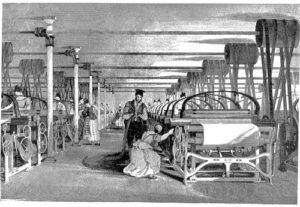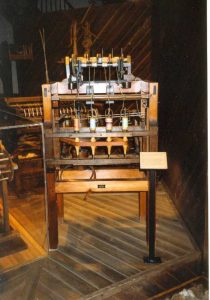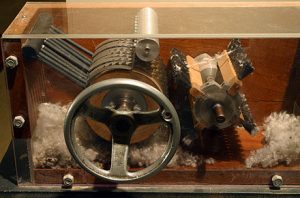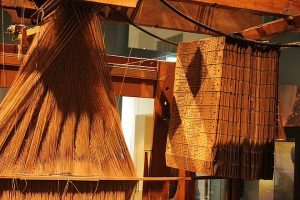Textile factories significantly grew during the First Industrial Revolution, especially British ones.

image source: https://en.wikipedia.org/wiki/Industrial_Revolution#/media/File:Powerloom_weaving_in_1835.jpg
The growing demand for clothing and cloth was satisfied by the integration of machinery in the factory system. Several inventions in textile machinery occurred in a relatively short period during the Industrial Revolution. Since they made weaving cloth and spinning yarn and thread much easier, producing cloth became faster and required less time and far less human labor.
Here is a timeline of the most interesting news:
1733
Flying shuttle: invented by John Kay: an improvement in looms that allowed weavers to weave faster.

image source: https://en.wikipedia.org/wiki/John_Kay_(flying_shuttle)
1742
Cotton mills were opened for the first time in England.
1764
Spinning jenny invented by James Hargreaves: the first machine to improve the spinning wheel, patented in 1770.

image source: https://en.wikipedia.org/wiki/Industrial_Revolution#/media/File:Spinning_jenny.jpg
1769
Richard Arkwright patented the water loom: the first motorized textile machine.

image source: https://en.wikipedia.org/wiki/Water_frame
1773
The first all-cotton fabrics were produced in factories.
1779
Crompton invented the spinning mule favoring greater control over the weaving process.

image source: https://en.wikipedia.org/wiki/Samuel_Crompton
1785
Cartwright patented the electric loom which was later improved by William Horrocks, known for his invention of the variable speed baton in 1813.

1789
Samuel Slater brought textile machinery design to the United States, spreading the effects of the British Industrial Revolution for the first time.
1790
Arkwright built the first steam-powered textile factory in Nottingham, England.
1792
Eli Whitney invented the cotton gin: the machine that automated the separation of cottonseed from short-staple cotton fiber.

image source: https://en.wikipedia.org/wiki/Eli_Whitney#/media/File:Cotton_gin_EWM_2007.jpg
1804
Joseph Marie Jacquard invented the Jacquard Loom that wove complex designs, inventing a way to automatically control the warp and weft threads on a silk loom by recording hole patterns in a series of papers.

1813
William Horrocks invented the variable speed baton for an improved electric loom.
1856
William Perkin invented the first synthetic dye.
Info sources:
https://en.wikipedia.org/wiki/Industrial_Revolution#Textile_manufacture https://www.thoughtco.com/textile-machinery-industrial-revolution-4076291
